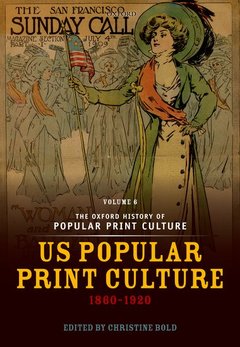The Oxford History of Popular Print Culture Volume Six: US Popular Print Culture 1860-1920 The Oxford History of Popular Print Culture Series
Langue : Anglais
Coordonnateur : Bold Christine

What did most people read? Where did they get it? Where did it come from? What were its uses in its readers' lives? How was it produced and distributed? What were its relations to the wider world of print culture? How did it develop over time? These questions are central toThe Oxford History of Popular Print Culture, an ambitious nine-volume series devoted to the exploration of popular print culture in English from the beginning of the sixteenth century to the present. Volume six explores a cornucopia of US popular print materials from 1860 to 1920, the period when mass culture exploded into the everyday lives of large swathes of the population. Thirty specially written essays by scholars from a wide range of disciplines - history of the book; literary, cultural, media, and film studies; social history, journalism, and American Studies - probe the material conditions, proliferating genres, and cultural work of newly affordable and accessible forms. A dozen short entries address additional topics, genres, and approaches. A chronology of the relevant legal, technological, and organizational developments of the period and a list of online and physical archives provide further support for study in this burgeoning field. Cumulatively, the volume revisions the power of 'the popular' in its many meanings - widely circulated, commercialised, vernacular, working-class, cheap, accessible; it recovers and analyses neglected cultural webs and networks, as well as individual authors, famous and forgotten; and it interrogates conventional cultural hierarchies and high/low binaries. The volume pursues some key issues in rich archival and analytical detail. How did new technologies of production and distribution shape a plethora of print forms, including advertising leaflets, postcards, tracts, pamphlets, dime novels, story papers, newspapers, magazines, and cheap books? How did upheavals in the publishing industry and new regulatory mechanisms affect circulation and consumption? How did various genres mediate social and political transformations of the period? How did popular print forms consolidate transnational and borderlands networks? How were particular cultural communities, including Native American, African American, Asian American, and Mexican / America alternately served and oppressed by popular print? How was it seized in support of labour and woman suffrage, and how was it wielded by governmental and educational institutions? How did print interact with other media?
General Editor's Introduction. Volume Editor's Introduction. I. Forms And Technologies Of Cultural Production. 1. The Changing Face of Publishing. 2. Story Paper Fiction. 3. Dime Novels. 4. Nineteenth-Century Reprint Libraries: When a Book Was Not a Book. 5. Newspapers. 6. The Magazine Revolution, 1880-1920. 7. American Advertising: A Poem for Every Product. 8. Postcard Culture in America: The Traffic in Traffic. 9. Early Motion Pictures and Popular Print Culture: A Web of Ephemera. 10. Internationalizing the Popular Print Marketplace. II. Popular Genres. 11. Religion and Popular Print Culture. 12. Labour and Popular Print Culture. 13. Juvenile Publications. 14. Westerns. 15. Science Fiction. 16. The Humour Industry. 17. Sensationalism. 18. Popular Poetry in Circulation. 19. The American Civil War. III. Case Studies. 20. 'To make something of the Indian': Hampton Institute and the Uses of Popular Print Culture. 21. 'To have the benefit of some special machinery': African American Book Publishing and Bookselling, 1900-1920. 22. Mexican / American: The Making of Borderlands Print Culture. 23. The Yellow Claw: The Optical Unconscious in Anglo-American Political Culture. 24. A Transatlantic Sensation: Stanley's Search for Livingstone and the Anglo-American Press. 25. Vision of Pacific Destiny: Imperial Geographies in the Overland Monthly, 1898-1900. 26. Rough Justice: Crime, Corruption, and Urban Governance. 27. Jacob Riis and Popularizing the Photography of Class Trauma. 28. American Suffrage Print Culture. 29. Understanding Readers of Fiction in American Periodicals, 1880-1914. IV. Appendices. 1. Additional topics: Advice Manuals and Self-Help Books, Detective Fiction, Literacy, Performance and Popular Print Culture, Photography and Popular Print Culture, Popular History, Popular Science, Pulp Magazines, Scrapbooks, Sentimentalism, Sports and Popular Print Culture, Workers' Autobiographies. 2. Selective Chronology. 3. Archival Resources.
Christine Bold is Professor of English at the University of Guelph. She is the author of three books -Selling the Wild West: Popular Western Fiction, 1860-1960 , The WPA Guides: Mapping America , and Writers, Plumbers, and Anarchists: The WPA Writers' Project in Massachusetts - as well as numerous chapters and articles on popular culture and cultural memory. She has also co-authored the award-winning book Remembering Women Murdered by Men: Memorials across Canada by the Cultural Memory Group, a collaboration between academics and social justice workers. She reviews regularly for the Times Literary Supplement , and she is currently writing a book titled The Frontier Club: Popular Westerns and Cultural Power, 1880-1924.
Date de parution : 12-2011
Ouvrage de 742 p.
18.1x25.3 cm
© 2024 LAVOISIER S.A.S.



